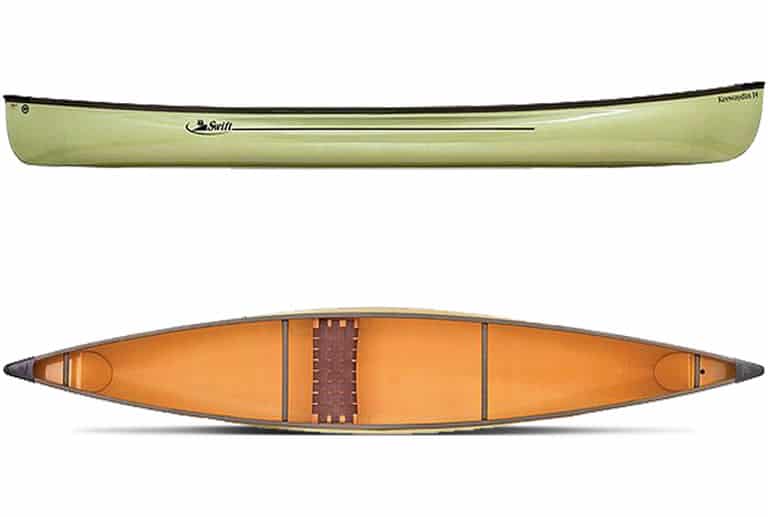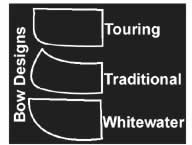Contents
- Flat Bottom Canoe Stability & Uses
- The Unique Flat Bottom Canoe Design Makes This A Perfect Leisure Boat
- What Is A Flat Bottom Canoe Called?
Flat Bottom Canoe Stability & Uses
A flat bottom canoe offers great primary stability and ease of paddling in calm water.
In calm conditions a flat bottom canoe is hard to capsize.
This means it is a great canoe for beginners, families and for recreational pursuits and fishing on calm inland waters.
It differs from other canoes in primary and secondary stability.
The Unique Flat Bottom Canoe Design Makes This A Perfect Leisure Boat
Before we look at the reasons for choosing a flat bottom canoe let’s first investigate the different canoe hull designs available.
The hull design of a canoe can greatly affect a canoe’s performance in different types of marine environments.
Just as is the case with a kayak, the design of the hull of a canoe affects both its primary stability and secondary stability.
I have covered primary and secondary stability as it relates to kayak here and the points raised are equally as applicable to a canoe.
If you want a deeper understanding of these stability issues you should read this article.
If you want a quick explanation of primary and secondary stability, then you can view them in this way:
- Primary stability refers to a boat’s ability to stay stable while sitting on the water, i.e. it’s resistance to capsizing when sitting on the water.
- Secondary stability refers to a boat’s ability to stay stable when it is tilted on its side, i.e. it’s resistance to capsizing when it is rocked on the water.

Primary stability and hull design
Primary stability is affected by the design of the canoe’s bottom.
Secondary stability is affected by the design of the canoe’s sides.
We will start with primary stability and thus the design of the bottom of the canoe to see how it affects the stability of a flat bottom canoe and those with other hull designs.
A canoe hull will fall into one of four categories.
These categories are:
- Shallow-v
- Shallow arch
- Flat bottom
- Round bottom
Let’s take a look at these design features in more detail.
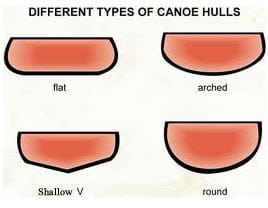
Shallow-v
A shallow-v canoe offers the most versatility among the canoe hull designs.
It offers some of the stability of a flat bottom canoe but has superior performance in rough water.
It is also better at tracking.
It does have less initial stability than a flat bottom canoe but if you plan to navigate choppy waters then a shallow-v offers better overall stability.
A shallow-v has a deeper draft (meaning the bottom of the boat sits lower in the water) and thus may snag on rocks or other debris in shallow waters.
Shallow arch
A shallow arch canoe, sometimes simply called arched, offers the most speed on calm waters and the most paddling efficiency.
It offers some of the stability of a flat bottom canoe but is better at tracking which makes it popular among river runners.
Flat bottom
A flat bottom canoe offers the best primary stability on calm water. It is also fairly easy to maneuver.
Unfortunately the flat bottom design means it is much less stable in challenging waters.
When the weather changes for the worse a flat bottom canoe can be unpredictable and in very choppy water with high winds it requires skilled paddlers to keep the boat afloat.
The stability is also negatively affected on a flat bottom boat as the load is increased.
However, as most beginners and day-trippers will be navigating calm inland waters a flat bottom canoe is by far their best choice of all the hull designs.
For calm rivers, lakes and streams etc. a flat bottom canoe is best.
Round bottom
Round bottomed canoes are very rare. They are only really seen in canoe races conducted on very calm water.
A rounded hull design means the boat encounters much less friction in the water making it faster than the alternatives but its rounded hull also makes it very unstable.
Of course as I touched upon above, the bottom of the canoe is not the only thing that affects its stability.
As the bottom affects primary stability the sides will affect secondary stability. Let’s see how the design of the sides does that.
Secondary stability and how it affects a canoe’s stability
Just as the sides of a kayak can influence the secondary stability of the boat so too the sides of a canoe affect its secondary stability.
The side of the canoe, especially above the waterline, will influence its carrying capacity, its seaworthiness and its ease of paddling.
A canoe’s manoeuvrability is greatly influenced by its rocker (in the same way a kayak’s manoeuvrability is influenced by the rocker as I covered here).
An increase in rocker on a canoe will allow the ends of the boat to rise much easier when it meets waves thus giving it increased secondary stability.
Canoes with no rocker, that have flat keel lines, will track straight but are difficult to maneuver.
A canoe with flared sides is more stable than a canoe with tumblehome when the paddler leans it on its side.
The canoe with flared sides is also much more seaworthy.
Canoes designed for whitewater will have flared sides with a bow and stern that is rounded to shorten the waterline and provide more buoyancy in choppy waves.
The sides of a canoe are:
- Straight
- Flared
- Tumblehome
Let’s look a little closer at these design characteristics to see how they affect a canoes’ performance.

Straight sides
Canoes with straight sides provide no particular benefit or limitation other than to maintain primary stability.
Many flat bottom canoes will have straight sides as primary stability is the main concern.
Because flat bottom canes are used on calm flat water they don’t need much secondary stability (if any at all).
Flared sides
A flared hull widens out near the gunwales.
A canoe with flared sides more effectively deflects waves and resists capsizing in choppy waters.
Tumblehome sides
Tumblehome is how the hull curves in toward the gunwales, it lets the paddler paddle close to the hull. You will see this design most often in one-man racing canoes.
When easy paddling is needed a canoe may have tumblehome, with the gunwale width smaller than the waterline width.
This type of canoe design means the boat doesn’t deflect water very well but is much easier to paddle.
Some canoes will have both flare and tumblehome incorporated into their design at different points on the same hull.
A word about canoe keels
Keels are not original to a canoe design.
They were initially introduced for structural purposes – to literally help hold the canoe together.
These days both designers and canoe users argue as to whether a keel has any significant effect on the boat’s performance.
However, most agree that a keel will help a canoe to track better but at the expense of paddling efficiency.
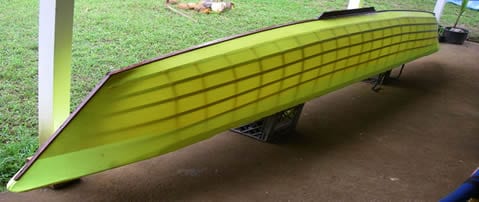
There are two types of keels:
- Shoe
- Tee
Shoe keels
Shoe keels are more suited to shallower waterways.
A shoe keel was designed to be shorter with a low profile so it can slide over rocks and river debris in shallow waters and rapids.
Show keels will most often be seen on river tripping canoes.
Tee keels
Tee keels are used for deep water canoeing.
Being longer they are unsuitable for very shallow water.
A word about the bow and stern of a canoe
The bow and stern of a canoe can also have different shapes designed for different purposes.
Entry line
 The entry line refers to the sharpness of the bow.
The entry line refers to the sharpness of the bow.
Sharp (pointed) entry lines will improve a canoe’s tracking capability.
However, blunt entry lines can resist impacts much better, which is why whitewater canoes will usually have blunt entry lines.
Stems
Stems refer to the shape of the front end of the canoe and the shape of the stern end. Stems can be squared or rounded.
A squared stem will be almost parallel to the deck whereas a rounded stem will come up in a curve to meet the bow.
A square stem improves a canoe’s tracking performance and a rounded stem improves a canoe’s steering and manoeuvrability.
The fullness of a canoe affects stability
The fullness of a canoe refers to how it widens from bow to the middle of the boat and from stern to the center line (middle of the boat).
Two canoes could be similar, or the same, width at their widest point (in the middle of the boat) but one can be fuller than the other.
If the canoe width only gradually increases (i.e. widens more between the middle of the boat and the stern and bow) then it will have less carrying capacity than a canoe that reaches fullness quicker.
The image below should help to clarify this design trait.
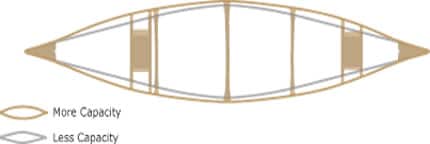
Not all canoes are symmetrical
Unlike a kayak not all canoes have identical halves; the part of the boat from the bow to the centerline may be different in design from the stern to centerline.
Asymmetrical canoes can be fish-form with the widest point ahead of center, or swede-form with widest point behind center.
These differences in design have their own pros and cons.
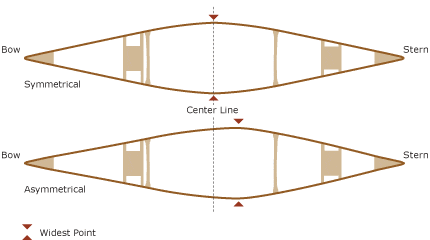
What Is A Flat Bottom Canoe Called?
Although a favorite among anglers a flat bottom canoe is used mostly for recreational purposes.
A flat bottom canoe is therefore often referred to as a recreational canoe.
It is used for leisurely trips along calm inland waters by individuals and families alike.
A flat bottom canoe is fun and easy to handle under the right conditions.
Why a flat bottom canoe is perfect for beginners
A flat bottom canoe is exceptionally stable in calm water.
Its stability is the reason it is usually chosen as the type of canoe for beginners and family outings.
However, there is a caveat; a flat bottom canoe has great primary stability but usually has poor secondary stability.
This means the boat is only stable in calm water.
If the wind picks up and creates very choppy water then a flat bottom canoe will lose its initial stability as it gets rocked on the waves.
This is why most flat-bottomed canoes will be used in shallow, calm inland lakes and rivers.
Flat bottom boat vs canoe
Which is a better choice a canoe or a flat bottom boat?
Well a flat bottom boat can offer many advantages over a canoe. A flat bottom boat, such as a Jon boat, tends to be lightweight.
Many Jon boat owners can load their boat on a vehicle trailer and unload it by themselves unlike most canoe owners.
A Jon boat will also offer more stability than a canoe especially if you have inexperienced passengers onboard.
A Jon boat has a design that is friendlier to the fitting of an outboard motor as well, giving you the option of higher speed.
In fact, even when paddling, a Jon boat will usually be faster than a canoe.
A Jon boat is a working boat. It is best suited to water-based utility work, the transportation of goods and people, fishing and hunting.
A canoe on the other hand is a great boat for simply exploring the water.

Canoes are great leisure boats and offer a fantastic fun way to spend time on the water alone or with your family.
They also look great!
If cost is an issue then you will probably be able to pick up a one-person canoe cheaper than a small Jon boat.
Of course the final choice really depends on the size, weight and design characteristics of each particular boat you are looking at.
For example, a large flat-bottomed skiff may not be able to access narrow waterways the way canoe can.
So why choose a flat bottom canoe?
A flat bottom canoe is a great way to spend fun time on inland waterways.
If you want a leisurely day on the water in calm weather, alone or with friends or family, then paddling in a flat bottom canoe is a great way to do it.
A flat bottom canoe is also great for the novice as it offers great initial stability and is hard to capsize when used on calm water.
Used on inland lakes and rivers a flat bottom canoe is also very easy to handle.
Just don’t use a flat bottom canoe in choppy water or when the weather turns nasty. Nor should you use one in the open sea unless you are very experienced (or it has outriggers fitted) as it has poor secondary stability and keeping the boat upright may prove to be a challenge.

